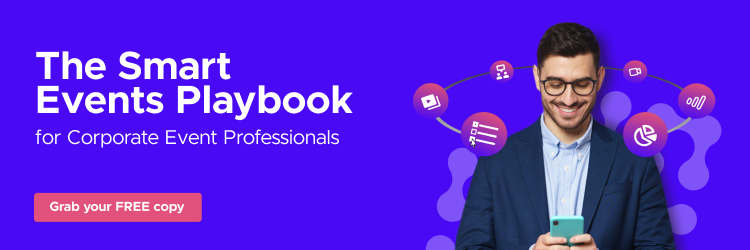5 Ways to Use Smart Event Data to Create High-Value Audience Journeys
Blog - 7 mins read
This article originally appeared in Conference News 09.01.2023
How in-house corporate event planners can leverage smart event data to grow audience share and create more opportunities.
Remember the days when measuring event performance used to rely entirely upon sweeping up the leftover badges on the registration table, having a 30-minute post-event debrief with fee earners or sales teams (if you were lucky) and forwarding a few thank-you emails from clients and speakers?
Covid turned event reporting on its head by offering granular data on virtual audience behaviour, although it was often more of a lift to translate virtual conversations into opportunities. Fast forward to 2022 and in-person events have returned with all the immediacy of face-to-face dealmaking but where is the data? In a recent ICE survey, 41% of in-person event organisers stated they did not have enough of it to meet their goals.
The truth, of course, is that just because data capture is rich, does not mean it is helpful. This might be why in the very same ICE survey, as many as 26% of respondents running virtual events indicated that they had “too much” data. Other surveys put this figure as high as 50%.
It’s a problem we hear repeatedly in the market; the information we capture just takes too much time and effort to translate into meaningful insights, we know it doesn’t tell the full story and our data is fragmented across multiple software systems.
But it doesn’t have to be this way. What if the data we collected really could inform the next step of the audience journey? What if we could measure how engaged our key accounts are across in-person and virtual touchpoints extending far beyond the event? Smart events (where interactive technology is interwoven throughout the event) offer more personalised, data-driven experiences for attendees.
They help event organisers:
– gain better insights based on what people actually do,
– increase the likelihood of converting leads over time
– demonstrate more ways to show ROI and engagement
How exactly can this be achieved? We’ve compiled five key ways to use smart event data (whether from virtual or in-person conferences) to create more value for you and your clients.
1. Personalise your audience journey and use data to generate more leads
By monitoring what content an individual interacts with before, during and after an event we can build a deeper picture of the topics that most interest them. Achieving this for a virtual event is relatively straightforward; for an in-person event, this additional data could come from an event app which enables:
– QR codes for session check-in
– Poll questions
– Collateral and slide downloads
– QR codes embedded in presentations
– Pre-event videos
– Interest tags in online profiles
– On-demand content
– QR codes for virtual content to augment exhibition stands (if you have these)
Once we know what they are interested in, we can invite that individual to a digital community and offer access to thought leadership articles, pdfs, videos etc. specifically on that topic. We can navigate them through an entire sequence of increasingly focused webinars, roundtables, social gatherings and other micro-events in their niche.
At every stage we can track what they are reading, clicking and attending, as well as what discussion tags are being used to see when they might be ready to open a conversation with a fee earner or salesperson. Tracking content like this generates useful data for retargeting adverts as well as personalised marketing possibilities. For example, when you start to publish sessions in your regional conference agenda, your event technology could detect which delegates have matching content tags and either highlight them to event organisers or automatically send the delegate a personalised invite highlighting the relevance of the session.
2. Measure topic popularity to determine future content strategy
An event thrives or dies on the strength of its content. Data can help you decide where you should be focusing your efforts next.
Smart events are powerful because they are designed to track what people actually do, as well as what they merely say they are interested in. They can show us this data in real-time and also over a much longer period of interaction. By developing a consistent content tagging system across your mobile app experience, webinars, roundtables, workshops, virtual events, CPD sessions, articles, thought leadership etc. you can start to build a rich picture of topics that are trending now and not just a year ago. You can also segment by audience; which sessions are the C-suite attending? Will they typically attend a follow-up webinar on the topic or not? If you have an online community, you could also use digital polls, or poll the audience at the end of a micro-event, to discover what they would most like to hear about.
Data analysis is always going to be a time investment. Having one platform to manage all your touchpoints for events, communities, webinars and learning gives your team a fighting chance. Firstly, it eliminates the time required to download and get it all into one format but also means you can start tagging and analysing content interaction much more easily.
3. Help delegates make and locate better connections
Using algorithmic matchmaking based on interest tags, via a mobile app or virtual platform environment helps delegates pinpoint connections with shared interests more easily.
So far so good. But what if you could do more? What if you could ask attendees (including your internal team) to tag their areas of expertise so that when a delegate downloaded a piece of content in their topic area, their profile was suggested? Tools such as in-room messaging where attendees can virtually scan the lecture theatre from their mobile phones can then close the loop, making the process of locating people easier.
4. Identify new influencers and subject experts
Encouraging delegates to make meeting requests using the platform or app, not only provides another dimension to event value but also enables you to measure who were the most highly sought-after people. You could use this data to approach certain influencers to do a video interview for marketing purposes, to ask to speak at a future event, add to a VIP list, or host a ‘brain-date’ style workshop.
There will inevitably be meetings scheduled outside of the booking tool. It may require some out-of-the-box thinking when it comes to how to capture these. For example, by measuring how often the words ‘meet’ or ‘coffee’ are used in one-to-one chats, whilst respecting the private nature of the message content.
5. Measure how much your key accounts are engaging
Yes, leads and opportunities are important, but so too are softer measures that can show engagement over time. By looking at all your registration and engagement data at a corporate company level, you can get another angle on how successful your account-based marketing is. For example, if Bupa was one of your key accounts you could measure year-on-year how many more live and asynchronous touchpoints they were interacting with, as a measure of success.
A recent McKinsey report highlighted the importance of omnichannel B2B sales and marketing, demonstrating that even amongst service industries a multi-touch methodology, leveraging virtual and in-person channels is becoming the favoured approach. Every point of interaction with your key customers, from in-person events to digital communities can be used as a lever to extend influence and build your pipeline.
In summary…
Covid may have opened the floodgates on data, but just because many of us have returned to in-person events doesn’t mean we have to turn our back on it. Instead, now is the time to take a more measured approach and track data because it is useful, not just because we can. One way to do this is by using the data you’ve already got to develop hypotheses about future events, so you can be selective about which data to prioritise looking at first.
The marketing expert and entrepreneur John Sculley once famously said “No great marketing decisions have ever been made on qualitative data.”
Will the same one day be said about events as well?

